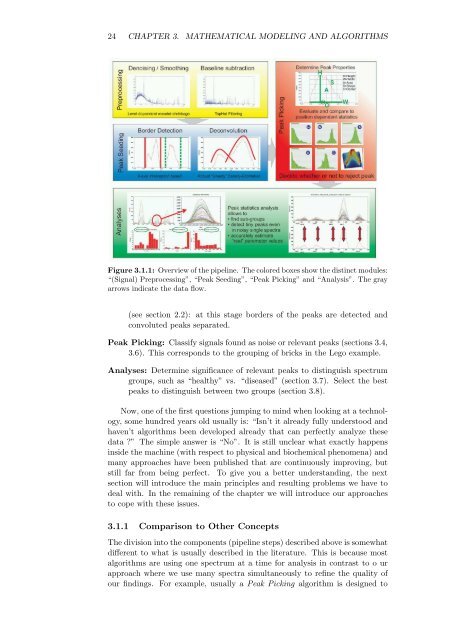New Statistical Algorithms for the Analysis of Mass - FU Berlin, FB MI ...
New Statistical Algorithms for the Analysis of Mass - FU Berlin, FB MI ...
New Statistical Algorithms for the Analysis of Mass - FU Berlin, FB MI ...
You also want an ePaper? Increase the reach of your titles
YUMPU automatically turns print PDFs into web optimized ePapers that Google loves.
24 CHAPTER 3. MATHEMATICAL MODELING AND ALGORITHMS<br />
Figure 3.1.1: Overview <strong>of</strong> <strong>the</strong> pipeline. The colored boxes show <strong>the</strong> distinct modules:<br />
“(Signal) Preprocessing”, “Peak Seeding”, “Peak Picking” and “<strong>Analysis</strong>”. The gray<br />
arrows indicate <strong>the</strong> data flow.<br />
(see section 2.2): at this stage borders <strong>of</strong> <strong>the</strong> peaks are detected and<br />
convoluted peaks separated.<br />
Peak Picking: Classify signals found as noise or relevant peaks (sections 3.4,<br />
3.6). This corresponds to <strong>the</strong> grouping <strong>of</strong> bricks in <strong>the</strong> Lego example.<br />
Analyses: Determine significance <strong>of</strong> relevant peaks to distinguish spectrum<br />
groups, such as “healthy” vs. “diseased” (section 3.7). Select <strong>the</strong> best<br />
peaks to distinguish between two groups (section 3.8).<br />
Now, one <strong>of</strong> <strong>the</strong> first questions jumping to mind when looking at a technology,<br />
some hundred years old usually is: “Isn’t it already fully understood and<br />
haven’t algorithms been developed already that can perfectly analyze <strong>the</strong>se<br />
data ?” The simple answer is “No”. It is still unclear what exactly happens<br />
inside <strong>the</strong> machine (with respect to physical and biochemical phenomena) and<br />
many approaches have been published that are continuously improving, but<br />
still far from being perfect. To give you a better understanding, <strong>the</strong> next<br />
section will introduce <strong>the</strong> main principles and resulting problems we have to<br />
deal with. In <strong>the</strong> remaining <strong>of</strong> <strong>the</strong> chapter we will introduce our approaches<br />
to cope with <strong>the</strong>se issues.<br />
3.1.1 Comparison to O<strong>the</strong>r Concepts<br />
The division into <strong>the</strong> components (pipeline steps) described above is somewhat<br />
different to what is usually described in <strong>the</strong> literature. This is because most<br />
algorithms are using one spectrum at a time <strong>for</strong> analysis in contrast to o ur<br />
approach where we use many spectra simultaneously to refine <strong>the</strong> quality <strong>of</strong><br />
our findings. For example, usually a Peak Picking algorithm is designed to









